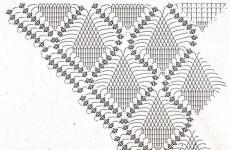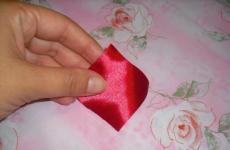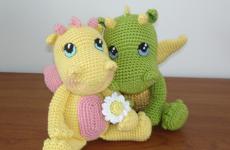DIY thread balls. We make decorative balls from thread and glue. Ideas for using balls - cobwebs
Greetings, masters and craftswomen!
Materials and toolswhich we will need:
Balloon (for smaller volumes, use finger pads, which are sold in pharmacies; for larger volumes, inflatable balls);
Threads (any thread is suitable: regular for sewing, floss, iris, wool for knitting);
Glue (PVA, silicate, stationery);
Needle, scissors;
Vaseline (you can use thick cream or oil);
For decoration: beads, feathers, beads, sparkles, semolina or powdered sugar, etc.
Step-by-step instructions on how to make a ball from threads:
1. Inflate the balloon to the desired size. Wrap a thread around the tail of the ball with a reserve of ~10 cm - for the future loop on which the ball will subsequently be hung to dry.
2. Lubricate the surface of the ball with Vaseline to make it easier to detach from the glued threads later.
3. Soak the threads with glue. When using threads of different colors, very beautiful weaves are obtained.
There are several ways:
- Pour the glue into some container that is convenient for you to work with, and soak the threads in it for 5-10 minutes. Dilute PVA glue with water (1:1) before soaking, as it is too thick. Make sure that the threads do not get tangled when soaking.
- Take a tube of glue and use a hot needle to make two holes in it opposite each other. Thread a thread through the holes using a needle (when pulled through the tube, the thread will be smeared with glue). Instead of a bottle of glue, you can take a Kinder Surprise egg, or another small plastic bottle, for example, a medicine bottle or the same silicate glue, and pour the glue into it.
- Wind the dry thread around the ball (skip step 4 and go straight to step 5), and then thoroughly saturate it with glue using a brush or sponge.
4. Secure the end of the thread soaked in glue to the ball (to secure the thread to the inflatable ball, you can use adhesive tape, tape, or protective tape). Then randomly wrap the thread around the entire surface of the ball, like a ball - each turn in the opposite direction. If the threads are thick, make fewer turns; if the threads are thin, wind them more tightly. Hold the threads in your hands with a slight tension, and also make sure that the thread is well wetted with glue. If the canister runs out of glue, refill it.
5. After winding, leave again a long tail for the loop, winding it again on the tail of the ball, cut the thread and hang the ball wrapped in threads to dry. Dry the ball thoroughly for 1-2 days - the finished cocoon should be hard. Do not try to speed up the process by hanging the balloon next to a heating device - the rubber from which balloons are made does not like this, and the hot air can cause the balloon to burst. An indispensable thing for drying is a clothes dryer with clothespins. You can dry several balls on the dryer at once, and they will not stick together.
6. When the glue has completely dried and hardened, the balloon must be removed from the web craft.
There are two ways:
1. Peel the ball off the web using a pencil with an eraser at the end. Carefully pierce the ball with a needle in several places and remove it or what is left of it.
2. Untie the knot that tied the balloon and it will gradually deflate. This method is mainly practiced when, instead of a balloon, you used an inflatable ball as the basis for winding.
7. Glue the finished cobweb balls together with a hot gun, pressing the gluing area slightly inward. The balls can also be sewn together, but this is not easy, because the balls become very strong and hard when dry.
8. Decorate the resulting design with beads, beads, feathers, braid, ribbons, artificial flowers, or any other materials at hand. Cover with paint. To do this, take a can of paint and go out onto the balcony or into the yard. With a slight movement of your hand, direct the colorful streams towards the balls awaiting a miraculous transformation. Create a snow effect: moisten the balls with glue and dip them in semolina or powdered sugar. Spray the ball with glitter hairspray. Don't expect much shine, but light sparkles are guaranteed.
Imagine...
small BIG tricks:
To prevent the table from getting dirty during the wrapping process, it is better to lay something plastic on it, not paper - everything will stick to the paper. Plastic coasters for hot dishes are suitable. If not, you can use a document corner made of thick plastic. The bottom seam is cut off, the folder is unbent and straightened, and it turns into a universal tool for saving the table from glue, paint and other creative deposits. In extreme cases, polyethylene is suitable for protecting the workplace.
Instead of glue, you can use sugar syrup or paste. Recipe for making paste: 4 teaspoons of starch per glass of cold water, mix thoroughly and bring to a boil.
Instead of thread, you can take thin copper wire and wind it around the ball in the same way.
To prevent glue from leaking through the hole in the floss tube, place a thin needle on the end of the floss and poke a piece of tape through it. Pull the thread in the opposite direction and firmly glue this tape to the jar. Thus, through a small hole in the electrical tape, the glue will not wet the thread so abundantly and will stop randomly dripping from the thread onto the table and clothes.
Be careful when winding the kokan. When dried, a poorly tied cocoon cracks and loses its shape as the ball descends.
Spider web balls can be not only spherical in shape. As a basis for winding, you can take a cone-shaped object (roll thick paper or cardboard into a cone), a heart, etc.
If you decide to change the color of a thread ball, then it is best to paint the ball before deflating and removing its base - so that the web does not become wrinkled when painting. In addition to aerosols, it is convenient to apply paint with a small sponge, inconvenient - with a brush and takes much longer.
To make the surface of the ball textured, you can coat the balls with glue and roll them in cereals, for example, millet or coffee beans.
And a few more words about threads...
If an air structure is being prepared, then the threads should be thin and light. For flower pots, it is better to take thick threads or even ropes and do not skimp on glue. The thread color can be any. True, it depends on the glue used. When the glue is transparent and leaves no traces, you can experiment by wrapping the ball with threads of different shades. It will turn out even more interesting.
Nice bonus:
For an innovative method of making spider web balls, see.
We are making an unusual holiday for a child - we decorate the house with rope balls. Such crafts can be used not only at a children's party, but also at a wedding celebration or party. There is nothing complicated in their production, everything is done quickly and interestingly, and most importantly - a minimum of resources and an original look.

For this you will need:
- yarn
- PVA glue
- Balloons
- starch
- Vaseline
- scissors
- a stick for hanging the product
- mixing bowl

Let's prepare a place to work. To do this, between two chairs you need to place a stick on which the balls will hang on ropes. In this case, it is better to lay out newspapers or a plastic bag on the floor.

Place the balls on the stick, making sure they don't touch.
Carefully coat each ball with Vaseline. This is done so that the thread does not stick and the ball quickly detaches from it.

Prepare the adhesive base: mix glue, starch and add a small amount of water. The end result should be a mixture similar to sour cream. Then put the yarn there and get rid of the excess. Tie one side of the thread to the ball and wrap it, first horizontally and then vertically. When everything is ready, you need to cut off the unnecessary part and tie a thread to the tail of the ball.


After this time everything is ready.

The last step is to pierce the ball and remove it. If you find any glue residue, just tap on it and it will come off easily.
How to make BALLS with THREAD and GLUE
This is how easy it is to make original holiday decorations from threads and PVA glue, also look at the article where a lampshade is made in the same way.
There is nothing more magical and exciting than creating a small miracle with your own hands, even if it was once invented and implemented by someone else. After all, you can always add something of your own to a craft: interesting additions or a piece of your soul.
And involving your own offspring in the process, who are looking for your attention and creative skills, will bring you closer and help you discover a lot of new and unknown things that are so rich in the world of crafts, useful or cute. So, today we will learn how to make a ball of thread and glue, consider different options for raw materials and various ideas for decorating a home, holiday table or children's corner.
We start with the selection of consumables
The variety of modern crafts designed to decorate our lives is enormous. Balls are simple but very impressive crafts.
A set of materials needed to create a souvenir:
Inflatable (air) balls of small diameter;
Any fatty cream or Vaseline;
A skein of thread you like, which we will use to decorate the ball;
Long (clamp) needle. It is required depending on the choice of glue and the method of wetting the thread with it;
Glue - stationery, PVA or specially made.
Before you learn how to make a ball of thread and glue, and before you start selecting materials to complete the work, you should decide on the size of the future craft, the quality of the thread, which will be the main decorative element, and the gluing method.
Balloon: basic requirements
Let's figure out how to make a ball of thread and glue with your own hands. The basis for making this souvenir are balloons.

When choosing them, you should be guided by the following considerations:
The balls should be round, since ovals require more accuracy, cannot always keep a given shape and are not as effective and versatile as regular spheres;
It is better to take balls that are not very large; a diameter of 8-12 cm is the best option, especially if this is the first craft.
And it is also important that the balloon be stronger, i.e. the cheapest option can fail at a decisive moment, deflating at the wrong time and ruining the future product. It is worth buying inflatable balloons with a reserve and carefully checking them before starting work.
Choosing glue
The successful completion of a craft largely depends on the composition of the glue. You can use stationery in a plastic bottle. This is where we need a thick needle. They pierce the walls of the bottle with it and pull the thread through the glue, thereby wetting it, preventing excessive wetting (the second wall of the bottle serves as a barrier). This is a good and economical method, but the use of PVA glue is more often welcomed by our craftsmen. This universal glue is more flexible, softer, and it seems that the craft processed with it is more pleasant to the touch and even warmer. Although each method has its adherents. PVA glue is heavy, so it is diluted with water in a 1:1 ratio, mixed well and poured into a flat container. Then a thread is passed through the glue solution. There is also a special recipe for glue that is most suitable for performing such work: add sugar to an aqueous solution of PVA. This mixture gives the manufactured crafts the necessary rigidity and strength. The glue proportions are as follows: 30 g of water, 15 g of glue, 4-5 teaspoons of sugar.

How to make a ball from thread and glue stick? This is also possible, but here the baby’s help will be necessary, since you need to pull the thread along the glue stick protruding from the case, pressing it well so that it has time to become saturated, and for this you need another pair of hands.
The main element of decoration is thread
The thread is selected depending on what you want to see at the output. You can use thick wool or acrylic threads.

There are many wonderful decorative yarns: with knots, sparkles, various flows and other interesting elements. The thickness of the thread is selected based on the functional load that the future craft will bear. Balls of large diameter, decorating large rooms, made of thick thread, jute or light cord, will look great. And elegant Christmas tree decorations-balls should be made of thin cotton, linen or artificial fibers. In other words, the question is not only how to make it, but also what exactly will decorate the souvenir. When the question of the place where the craft will be located has been decided, they begin to implement the idea.
Preparation of the workplace
The surface on which the process of the appearance of craft balls will take place should be protected from the aggressive effects of the starting materials. It is especially difficult to wipe off silicate glue from the countertop. A piece of oilcloth or garden film will help out. They cover the work surface. Before you make a ball of thread and glue, you need to protect your own clothes and hands. An apron and gloves made of silicone or thin rubber will be very useful here.
How to make a ball of thread with your own hands
So let's get started. Pour some of the prepared glue into a narrow container (we are talking about how to make a ball of thread and PVA glue). Place a skein of the selected thread next to it. We inflate the round ball to the required size and tie it tightly, leaving a fairly long end of the thread as a fastener, which will be useful when drying the finished souvenir. Lubricate the inflated balloon with prepared cream, Vaseline or any oil. This is done so that the ball does not stick to the threads. If this happens, it will be impossible to tear off and remove the remains of the ball from the resulting sphere without deforming the craft. Dipping the thread into a container with glue and wetting it, we begin to wrap the ball. You can apply turns, slightly pulling the thread, in any order or randomly, depending on the intended option.

It was already mentioned above how to make a ball from thread and stationery glue. You will need a thick needle with which you can pull the thread through a bottle of glue and wind it in the same way as when working with PVA glue.
Drying Features
After the ball is wrapped, it should dry completely. This is where you will need the long end of the thread. When drying, the ball should not come into contact with any surfaces, so the best option would be to tie it to a horizontal stick, fixed in the place where the crafts will dry, without disturbing anyone. It takes quite a long time for complete drying - 1-2 days. But there is no need to speed up this process. Heating devices located close to hanging crafts can deform them. If you overdo it with heating, the source ball may burst and nullify all efforts. Therefore, you should not make unnecessary efforts. Let the balls dry naturally.
Final stage
After a good drying, the threads wrapping the ball will harden perfectly and will keep their shape. Now you need to carefully remove the original rubber ball, which serves as a kind of frame. You can simply pierce it with a needle and, when it deflates, pull it out of the resulting sphere using a hook.

That's all. The craft is ready. Today we learned how to make a ball from thread and glue. It can be used as is, or it can be decorated with sequins, crystals, artificial flowers, etc. Balls coated with acrylic spray paint make great Christmas tree decorations. All shades of bronze, gold and silver are especially impressive. Such balls often serve as the basis for elegant decorative compositions, and are also used as single accents in decorating the space around us.
Evgenia Smirnova
To send light into the depths of the human heart - this is the purpose of the artist
Content
Many of us know how to make a ball of thread from school labor lessons in primary school. With the help of such a thread ball you can decorate any room, adding a touch of originality and warmth to it. In addition, a hand-made and unusually decorated thread ball can be an excellent gift for your family and friends. That is why your favorite useful advice site will tell you how to make a ball of woven thread with your own hands.
So, to make an original ball of thread you will need:
- threads - give preference to natural ones, for example, cotton or viscose, which absorb glue well;
- a thick long needle, which is also called a gypsy needle;
- a jar of PVA glue;
- balloons;
- napkins for wiping off excess glue.
Step-by-step instruction:
First, inflate the balloons. Inflate them to the size you want your yarn balls to be in the future. You can make balls of different sizes, depending on how you plan to decorate them in the future.

Thread the thread into the needle. Use a needle and thread to pierce the tube of glue. The thread, passing through the glue, will be saturated with it. Now you can remove the needle, we won't need it anymore.

Each balloon should now be wrapped with thread soaked in PVA glue. Try to ensure that it fits tightly to the surface of the ball. Wrap tightly, use more thread, don't skimp. When you wind the last layers of thread into the thread, already at the exit from the jar of glue, you can thread beads that will add originality to your ball. But leave this step at your own discretion.

After all the threads are wound around all the balls, the most difficult thing remains - wait until the glue dries. It is best to make such ball blanks in the evening, then you can go to bed with peace of mind, and in the morning the ball blanks will have time to dry completely, and you can proceed to the next step of the instructions.
Using a needle, burst the balloons, and carefully remove the remains through the hole in the thread ball. If you want to use the balloon again, simply untie the thread that was tightening the inflatable hole, deflate the air and carefully remove the deflated balloon. The spider web balls are ready. Now you can decorate them to your taste and decorate your room with them.

Balls of thread beautiful, airy and will decorate any interior. Moreover, using this method you can make almost any three-dimensional object, for example, a lampshade, vases, animal figurines, etc.
We will need :
Balloon;
PVA glue;
Thick cotton threads;
Cling film;
Petrolatum;
A plastic cup.
To balls turned out smooth and dense, you need to be very careful about the quality of the PVA glue and threads. I used this glue from Tury - Profi PVA glue - I recommend it. Don't take PVA glue from the office supply department. Many of them do not stick well to paper.
The threads are needed so that their composition is mainly cotton. This is a more porous material and is better saturated with glue. Under no circumstances use completely synthetic threads; they will not be well saturated with glue, and your ball will be soft and will not hold its shape well.
I bought “Peony” knitting threads from the St. Petersburg factory named after. Kirov. Their composition: 70% cotton, 30% viscose. They are dense, but quite voluminous and take a lot of glue (this is good for holding their shape). My second batch was made from floss from the same mill. Balls Of the "Peony" threads, I liked them better.
We take a regular rubber ball and inflate it to the size we need. I had a conveyor belt, so I inflated 6-7 pieces at once. Tighten the pimp thoroughly so that the ball does not deflate when drying, otherwise the whole structure will become warped :)
Wrap the inflated ball in cling film. I left the tail uncovered to make it easier to blow off the balloons later. Yes, I didn’t pierce them, but blew them off, because if you do everything carefully, the rubber ball can serve us more than once or twice :)
Then we take Vaseline and smear the ball wrapped in cling film. This will prevent the threads from sticking to the ball and will not damage their shape. Yes, in the photo it’s Vaseline :) I took the photo in the process, so my hands were dirty, the camera in my hands was shaking and jumping :)
Now the important point. How to prepare thread for wrapping. To prevent the thread from getting tangled and not being too wet from the glue, it must be passed through a cup of glue. Creating the first ball of thread, I put the threads in a bowl of glue, that is, I simply dipped them there. The threads were too wet, constantly tangled and curled into knots. And, of course, there was glue all around :) There was more glue on the hands than on the threads :) So I took a plastic disposable cup, made two holes with an awl on both sides (closer to the bottom, but not quite low) and threaded them through thread. Then I poured PVA glue so that it covered the thread. The photo shows how the thread passes through the glass. This system allows the thread not to get tangled and to absorb as much glue as needed. I placed the ball itself in a large mug so that it wouldn’t jump around the table :)
I simply pulled the thread through the cup of glue, gradually wrapping it around the ball.
This is the design. An important element is a good series or movie :)
The ball is wrapped. Wrap evenly without leaving large holes.
I hung all the blanks in the bathroom to dry. I dried it all night, although you can remove it earlier - after 3-4 hours.
After final drying, I deflated the rubber ball and pulled it out along with the film. These are the thread cocoons we got.






